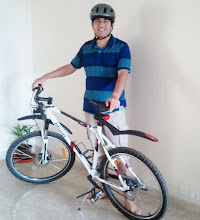Propaganda of “Happy
Cows” is probably one of the best examples regarding how industries deceive the
public and convert them as customers. What happens in the background is portrayed
in a very positive way, even though the reality is quite different and harsh.
Check out
following advertisements about “Happy California Cows” – they give very happy
picture indeed, isn’t it? Of course, everyone understands that it is
exaggerated (not sure about young children though), but customers will anyway
tend to think that California cows lead a reasonably good life, and hence they
will feel quite happy to use products that come from such happy cows.
But the violation
of fundamental rights of cows gets totally hidden in the process. Check out these links now.
So,
if you are a lacto-vegetarian and if you are thinking that you are being quite
cruelty free by staying away from meat, please think again – whether it is
California or anywhere else, the main mantra these days is:
“Most
of the animals slaughtered by CVM are "spent" dairy cows who are no
longer economically viable as milk-producers to the dairy industry.”
Do
you think any cow will be happy in modern day dairy industry where it leads a
totally unnatural life?
-
Almost
complete captivity with hardly any freedom of movement
-
Artificial
insemination and zero right to have sex or choose its own partner
-
Artificial
medication, hormone treatments to increase milk production
-
Unnatural
feeds and deprivation from grazing
-
Separation
from younger ones and denial of right of proper motherhood, family life
-
Finally,
unnatural (and often extremely cruel) death
Ahimsa
Milk
Ok,
now let’s ponder upon whether this is only a modern day evil and if we can have
a better solution on the basis of ancient day wisdom… Have you heard about a
concept called Ahimsa Milk? Please read about a unique attempt in UK.
As
a vegan, I strongly believe that there is nothing called truly Ahimsa Milk,
because I am convinced that without imposing several restrictions on animals
and without subjecting them to our rules (instead of letting them be as per
their own natural instincts), it is impossible to get milk from them.
Note: Beyond the ethical angle, I
am also deeply concerned about the health aspect of animal milk i.e. the myth about
the animal milk being very healthy for human beings, and also about environment
impact of animal farming. But let’s keep that aside for now.
My belief was
later reinforced by following interview of Ahimsa Milk management.
The responses by
management clearly indicate two things:
a) They do
care and are trying to find a solution
b) They are
also realizing that their project is far from a sustainable solution
Around
the world, we have enormous number of vegetarian Hindus who consider cow as
holy, but they are also in a state where they cannot easily accept quitting
dairy products overnight and embrace veganism. Acknowledging this fact, I would
feel happier (on a relative scale) if more and more such people at least start
demanding for this kind of Ahimsa Milk, and get ready to pay more for the same.
Slowly, it will dawn upon to them that veganism is the truly sustainable and
compassionate solution.
Related
Articles:

3 comments:
ಇಲ್ಲಿ ಕನಿಷ್ಠ ಮನುಷ್ಯ ದೃಷ್ಟಿಯಿಂದ (ಭಾವನೆಗಳಲ್ಲ, ಬರಿಯ ನೋಟಕ್ಕೆ) ಆರೋಗ್ಯಕರ ಪರಿಸರವಾದರೂ ಇದೆ. ಮಂಗಳೂರಿನ ಕುದ್ರೋಳಿ ಕಸಾಯಿಖಾನೆಯಲ್ಲಿ ಪರಿಸರವೂ ಕೊಳೆತಿದ್ದು, ಹಿಂಸೆ ಇನ್ನೂ ಭೀಕರವಾಗಿರುವುದನ್ನು ಕಂಡು ಕಂಗಾಲಾಗಿದ್ದೇನೆ. ಆದರೆ (ಗೊಬ್ಬರ, ಕೀಟನಾಶಕದಂಠ) ರಾಸಾಯನಿಕವಿಲ್ಲದ ಸಸ್ಯ ಉತ್ಪನ್ನ, (ಮಣ್ಣಿನ ಮೇಲೆ) ವಿಷಪ್ರಯೋಗವಿಲ್ಲದ ಹತ್ತಿಬೆಳೆಯ ತೊಡವುಗಳು, ಪಾರಿಸರಿಕ ಅನಾಚಾರವಿಲ್ಲದ ಸಾರಿಗೆ, ದೈನಂದಿನ ಅಗತ್ಯಗಳು ಎಂದೆಲ್ಲಾ ಅರಸುತ್ತ ಹೋದರೆ ಪ್ರಾಮಾಣಿಕವಾಗಿ ಕೇಳುತ್ತೇನೆ - ನಮಗೆ ಬದುಕುವ ದಾರಿಯುಂಟೇ? ಹಾಗಾಗಿ ಆದರೂ ಒಂದು ಹಂತದ ಮರೆವನ್ನು ಆರೋಪಿಸಿಕೊಂಡು ಮಾರುಕಟ್ಟೆಯಲ್ಲಿ ಕಣ್ಣಿಗೆ ಕಾಣುವಂತೆ ಶುದ್ಧವಾಗಿ ದೊರಕುವ ಆಹಾರವಸ್ತುಗಳು,ಮೋಟಾರು ವಾಹನಗಳು, ವಿದ್ಯುತ್ಛಕ್ತಿ ಇತ್ಯಾದಿಗಳೊಡನೆ ಹಾಲಿನ ಉತ್ಪನ್ನಗಳನ್ನೂ ಬಿಡಲಾಗದೆ ಮುಂದುವರಿದಿದ್ದೇನೆ. ಅಳುವುದೋ ನಗುವುದೋ ಗೊತ್ತಿಲ್ಲ :-(
ಅಶೋಕವರ್ಧನ
ಚಿಕ್ಕಂದಿನಿಂದಲೂ ಹಸುಗಳನ್ನು ಸಾಕಿರುವ ಮನೆಯಲ್ಲಿ ಬೆಳೆದ ನನ್ನ ಅನಿಸಿಕೆ ಇದು:
ನಾನು ಕ್ಯಾಲಿಫೋರ್ನಿಯಾ ಮತ್ತು ವಿಸ್ಕಾನ್ಸಿನ್ (America's dairyland) ಎರಡೂ ಕಡೆಗಳಲ್ಲಿ ಡೈರಿಗಳಿಗೆ ಭೇಟಿ ಕೊಟ್ಟಿದ್ದೇನೆ. ಯಾವುದೇ ರೀತಿಯಲ್ಲೂ ಅಲ್ಲಿನ ಹಸುಗಳನ್ನು happy cows ಎಂದು ಕರೆಯಲಾಗದು. ಅವು ಬದುಕಿದ್ದದ್ದು ಅತ್ಯಂತ ದಯನೀಯ ಸ್ಥಿತಿಯಲ್ಲಿ; ಅಮೇರಿಕಾದ ಫಾರಂ ಗಳಲ್ಲಿ ಹೆಚ್ಚು ಜಾಗ ಇರುವುದರಿಂದ ಅಲ್ಲಿ ಹಸುಗಳು ಕನಿಷ್ಠ ಪಕ್ಷ ಸಾಕಷ್ಟು ಓಡಾಡುವ ಸ್ವಾತಂತ್ರ್ಯ ಹೊಂದಿರಬಹುದು ಎಂದು ನಾನು ಭಾವಿಸಿದ್ದೆ; ಆದರೆ ನಾನು ಕಂಡದ್ದು ಒಂದು ದೊಡ್ಡ barn ನಲ್ಲಿ ೧೦೦-೨೦೦ ಹಸುಗಳನ್ನು ದಬ್ಬಿ ಇಟ್ಟಿದ್ದರು; ಒಂದಕ್ಕೂ ಸ್ನಾನವಿಲ್ಲ; ಸಗಣಿ - ಕೊಚ್ಸೆಗಳಲ್ಲಿಯೇ ಇದ್ದ ಹಸುಗಳು; ಹೊಲಗಳಲ್ಲಿ ತರಕಾರಿಗಳು ಹೇಗೆ ಇರುತ್ತವೆಯೋ ಹಾಗೆಯೇ ಅಲ್ಲಿ ಹಸುಗಳೂ ಇದ್ದದ್ದು (ಕೊನೆಗೆ ಎರಡರ ಗತಿಯೂ ಅದೇ - ಕತ್ತರಿಸುವುದು).
ನಮ್ಮ ಬೆಂಗಳೂರಿನಲ್ಲಿ ಡೈರಿ ದಂಧೆ ನಡೆಸುವವರು ಹಸುಗಳನ್ನು ಚೆನ್ನಾಗಿ ನೋಡಿಕೊಳ್ಳುವುದೂ ಸಹ ಅಷ್ಟರಲ್ಲೇ ಇದೆ; ಕೃತಕವಾದ cattle ಫೀಡ್, ಕರುಗಳಿಗೆ ಒಂದು ವರ್ಷ ವಯಸ್ಸಾಗುವುದಕ್ಕೂ ಮೊದಲೇ ಬಲವಂತವಾದ ಗರ್ಭ ಧಾರಣೆ, ಗಂಡು ಕರುಗಳು ಕಣ್ಣು ತೆರೆಯುವ ಮೊದಲೇ ಕಸಾಯಿ ಖಾನೆಗೆ.
ನಾನು ನೋಡಿರುವ ಮಟ್ಟಿಗೆ ಹಸುಗಳನ್ನು ಚೆನ್ನಾಗಿ ಕಾಣುವುದು ನಮ್ಮ ದೇಶದ ಗ್ರಾಮಾಂತರ ಪ್ರದೇಶಗಳಲ್ಲಿ. ಇದಕ್ಕೆ ಮುಖ್ಯ ಕಾರಣ ಹಳ್ಳಿಗಳಲ್ಲಿ ಹಸುಗಳನ್ನು ಸಾಕುವವರು ಡೈರಿ ಉದ್ಯಮ (ದಂಧೆ ಇನ್ನೂ ಸರಿಯಾದ ಪದ) ನಡೆಸುವವರಲ್ಲ. ತಮ್ಮ ಮನೆಯ ಅಗತ್ಯಕ್ಕೆ, ಮತ್ತು ಸ್ವಲ್ಪ ಮಟ್ಟಿಗೆ ಮಾತ್ರ ಮಾರುವುದಕ್ಕೆ ಹಸುಗಳನ್ನು ಸಾಕುವವರು. ಹೀಗಾಗಿ ಹಸುಗಳನ್ನು ತೀರಾ ಹಿಂಸಿಸಿ ಅವುಗಳಿಂದ ದೊರೆಯುವ ಒಂದೊಂದು ಹನಿ ಹಾಲನ್ನೂ ಹಿಂಡುವ ಮನೋವೃತ್ತಿ ಕಂಡು ಬರುವುದಿಲ್ಲ. ಕರು ಹುಟ್ಟಿಸುವುದಕ್ಕೂ ಸಾಮಾನ್ಯವಾಗಿ ಹಳ್ಳಿಗಳಲ್ಲಿ "ದೇವರ ಗೂಳಿ" ಯನ್ನು ಉಪಯೋಗಿಸುವುದು artificial insemination ಗಿಂತ ಹೆಚ್ಚು ಸಾಮಾನ್ಯ. ಜೊತೆಗೆ ನಗರ ಪ್ರದೇಶಗಳಲ್ಲಿ ಹೆಚ್ಚಿನ ಹಾಲಿನ ಉತ್ಪಾದನೆಗೊಸ್ಕರ ಭಾರತೀಯ ತಳಿಗಳಿಗಿಂತ ಡೆನ್ಮಾರ್ಕ್ ನ ತಳಿಗಳನ್ನು ಸಾಕುತ್ತಾರೆ - ಇವು ನಮ್ಮ ಹವಾಮಾನಕ್ಕೆ ಹೊಂದಿಕೊಳ್ಳಲಾರದೆ ಒದ್ದಾಡುತ್ತವೆ. ಗ್ರಾಮೀಣ ಪ್ರದೇಶಗಳಲ್ಲಿ ಸಾಮಾನ್ಯವಾಗಿ "ನಮ್ಮ" ತಳಿಗಳು ಸಾಮಾನ್ಯ (ಮಲೆನಾಡು ಗಿಡ್ಡ, ಹಳ್ಳಿಕಾರ್, ಇತ್ಯಾದಿ). ಇವು ಹಾಲು ಕೊಡುವುದು ಕಮ್ಮಿಯಾದರೂ ಹಸು ಮತ್ತು ರೈತ ಇಬ್ಬರೂ ಹೆಚ್ಚಿನ ನೆಮ್ಮದಿಯಿಂದ ಇರುವುದು ಹೌದು.
ಪ್ರಿಯ ಅಶ್ವತ್ಥಾ, ಎಷ್ಟು ಗ್ರಾಮಾಂತರ ಪ್ರದೇಶಗಳಲ್ಲಿ ಬಹುಮಟ್ಟಿಗೆ ನೀನು ಹೇಳಿದಂತಹ ಸಂಬಂಧ ಉಳಿದುಕೊಂಡಿದೆಯೋ ಗೊತ್ತಿಲ್ಲ. ದಕ್ಷಿಣ ಕನ್ನಡದ ಮಟ್ಟಿಗೆ ಹೇಳುವುದಾದರೆ, ಸ್ಥಿತಿಗತಿ ಈಗಾಗಲೇ ಬಹಳಷ್ಟು ಹಳಸಿದೆ. ಮೇಯಲು ಜಾಗ ಇಲ್ಲ, ಬಿಟ್ಟರೆ ಕದ್ದುಕೊಂಡು ಹೋಗುತ್ತಾರೆ, ಹೋರಿಗಳು ಲಾಭದಾಯಕವಲ್ಲ, ಉಪಯುಕ್ತವಲ್ಲ - ಎಂಬಿತ್ಯಾದಿ ವಾದಗಳೇ ಹೆಚ್ಚು ಕೇಳಲು ಸಿಗುತ್ತವೆಯೇ ಹೊರತು ದನ-ಎತ್ತುಗಳ ಬಗ್ಗೆ ನೈಜ ಕಳಕಳಿಯಿಂದ ಮಾತನಾಡುವವರು ಸಿಗುವುದು ಕಡಿಮೆ. ಎಲ್ಲಾ human-centric.
Post a Comment